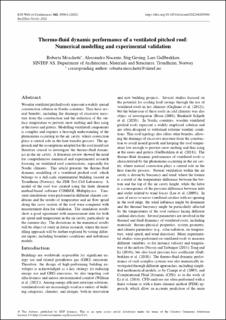| dc.contributor.author | Moschetti, Roberta | |
| dc.contributor.author | Nocente, Alessandro | |
| dc.contributor.author | Geving, Stig | |
| dc.contributor.author | Gullbrekken, Lars | |
| dc.date.accessioned | 2022-12-16T08:17:30Z | |
| dc.date.available | 2022-12-16T08:17:30Z | |
| dc.date.created | 2022-12-07T13:58:07Z | |
| dc.date.issued | 2022 | |
| dc.identifier.citation | E3S Web of Conferences. 2022, 362 . | en_US |
| dc.identifier.issn | 2267-1242 | |
| dc.identifier.uri | https://hdl.handle.net/11250/3038151 | |
| dc.description.abstract | Wooden ventilated pitched roofs represent a widely spread construction solution in Nordic countries. They have several benefits, including the drainage of excessive moisture from the construction and the reduction of the surface temperature to prevent snow melting and thus icing at the eaves and gutters. Modelling ventilated components is complex and requires a thorough understanding of the phenomena occurring in the air cavity, where convection plays a central role in the heat transfer process. The approach and the assumptions adopted for the roof model are therefore crucial to investigate the thermo-fluid dynamics in the air cavity. A literature review showed the need for comprehensive numerical and experimental research focusing on ventilated roof constructions, especially for Nordic climates. This article presents the thermo-fluid dynamic modelling of a ventilated pitched roof, which belongs to a full-scale experimental building located in Trondheim (Norway), the ZEB Test Cell Laboratory. A model of the roof was created using the finite element method-based software COMSOL Multiphysics. Transient simulations were performed in different climate conditions and the results of temperature and air flow speed along the cross section of the roof were compared with measurement data for validation. The simulation results show a good agreement with measurement data for both air speed and temperature in the air cavity, particularly in the summer day. The deviations in the numerical results will be object of study in future research, where the modelling approach will be further explored by testing different inputs, including boundary conditions and turbulence models. | en_US |
| dc.language.iso | eng | en_US |
| dc.publisher | EDP Sciences | en_US |
| dc.rights | CC BY 4.0 | * |
| dc.rights.uri | http://creativecommons.org/licenses/by/4.0/deed.no | * |
| dc.title | Thermo-fluid dynamic performance of a ventilated pitched roof: Numerical modelling and experimental validation | en_US |
| dc.type | Peer reviewed | en_US |
| dc.type | Journal article | en_US |
| dc.description.version | publishedVersion | en_US |
| dc.rights.holder | © 2022 The authors | en_US |
| dc.subject.nsi | VDP::Teknologi: 500 | en_US |
| dc.source.volume | 362 | en_US |
| dc.source.journal | E3S Web of Conferences | en_US |
| dc.identifier.doi | 10.1051/e3sconf/202236205004 | |
| dc.identifier.cristin | 2090115 | |
| dc.source.articlenumber | 05004 | en_US |
| cristin.ispublished | true | |
| cristin.fulltext | original | |
| cristin.qualitycode | 1 | |

